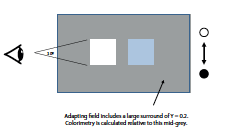
This paper investigates the impact of the Helmholtz-Kohlrausch effect on near-white substrate colours. As the luminance of the test colour (or its simulated reflectance in a softproof setup) approaches that of the adapting white point the viewing mode changes from 'surface mode' to 'aperture mode', and the appearance of the test colour becomes self-luminous. However, some substrates with optical brighteners fall close to this threshold between viewing modes, since the OBAs not only increase the perceived reflectance but also increase the H-K effect, where it is very prominent in bluish colours. For graphic arts content shown on a display system, this essentially breaks the soft-proofing paradigm. The practical application of this work relates to cross-media colour reproduction, where the lightness appearance of some substrates is not adequately described by their colorimetric values, and this may impact on choice of proofing strategies.